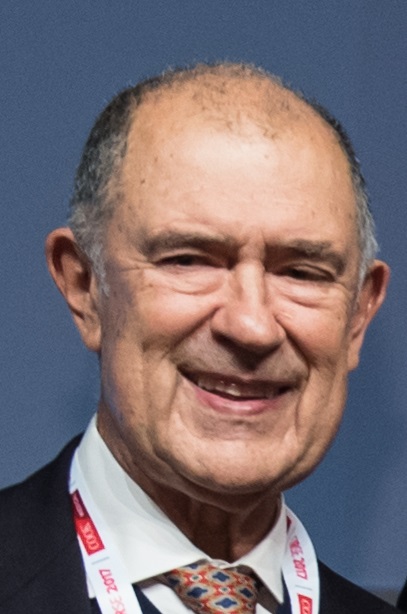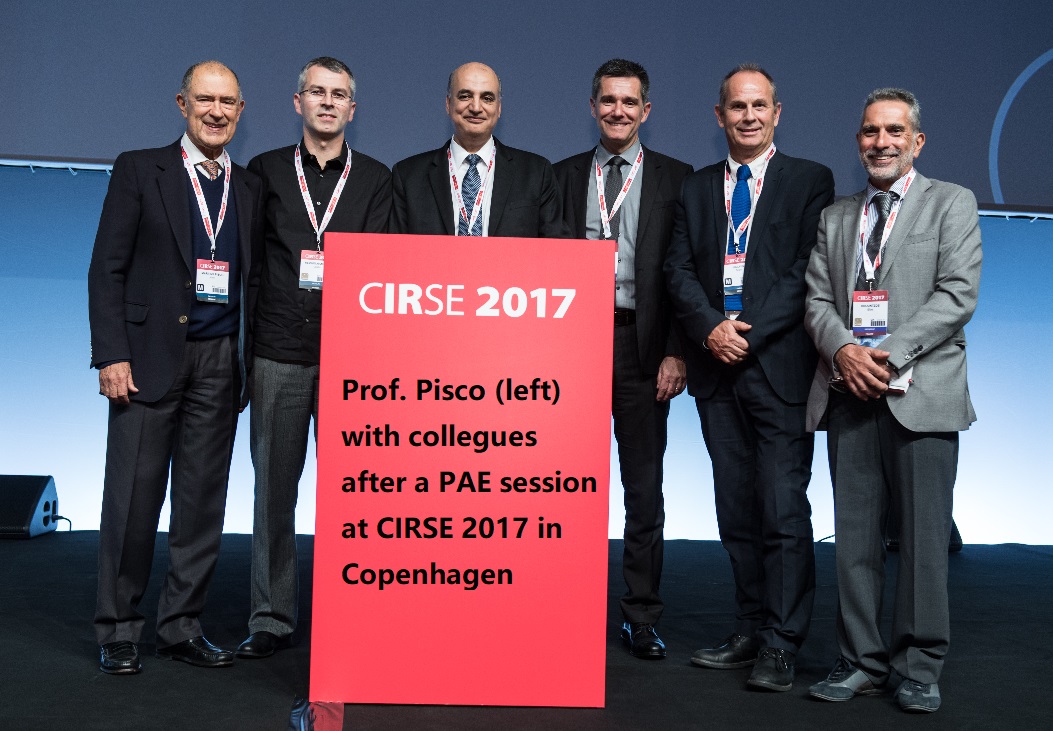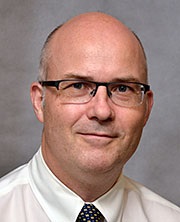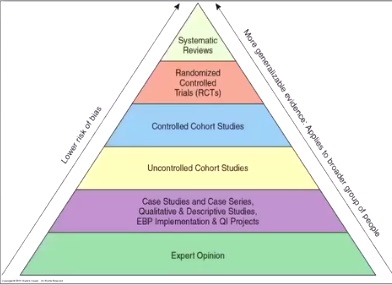 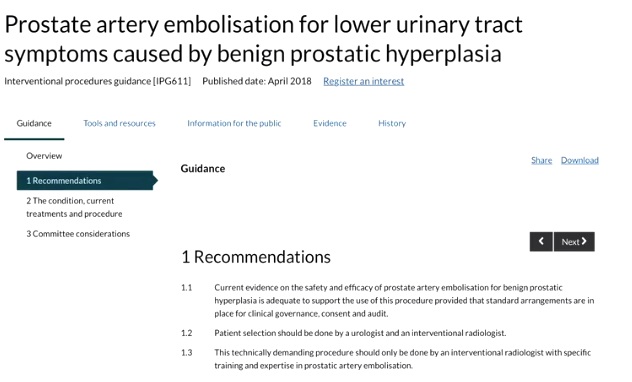 美国泌尿协会指南中的PAE之路
There are substantial differences amongst guideline recommendations regarding the use of prostate artery embolization (PAE) in the treatment of lower urinary tract symptoms/benign prostatic obstruction (LUTS/BPO), which can be partially explained by different interpretation of the evidence.
关于使用前列腺动脉栓塞(PAE)治疗下尿路症状/良性前列腺梗阻(LUTS/BPO)的指南建议之间存在显著差异,这可以部分用对证据的不同解释来解释。
This is the conclusion presented by Dominik Abt (Klinik für Urologie, Institut für Medizin, Universität St Gallen, St Gallen, Switzerland) at the Global Embolization and Cancer Symposium Technologies (GEST) 2
这是Dominik Abt(瑞士圣加仑圣加仑大学医学研究所泌尿外科)在全球栓塞与癌症研讨会技术(GEST)2021上提出的结论
Focus Day on prostate artery embolization (PAE; 6 March, online).
前列腺动脉栓塞聚焦日(PAE;3月6日,在线)。
This virtual meeting sought to open discussion between urologists and interventional radiologists regarding the place of PAE in the treatment algorithm, a topic of heated debate in recent years.
这次虚拟会议试图开启泌尿科医生和介入放射科医生之间关于PAE在治疗算法中的位置的讨论,这是近年来激烈争论的话题。
虽然这证明了栓塞中位叶是可行的,但Little 问他:“这在临床上意味着什么,这些患者会变得更好吗?”他转向2021年的GEST联合创始人Marc R. Sapoval、第一作者Tom Boeken(两人都是法国巴黎 Européen Georges-Pompidou 医院)等人的一项研究中得出结论,IPP“不是良性前列腺增生(BPH)PAE无效的预后标志”。Sapoval, Boeken和同事还写道,严重的突出可能会导致对PAE患者的更好反应,“尽管预期的前列腺高度下降是轻微的”。他们发现IPP的程度并不限制PAE对因BPH引起的下尿路症状(LUTS)患者的疗效。
Speaking during the final session of the day, panel chair and co-course organiser Jafar Golzarian (University of Minnesota, Minneapolis, USA) praised the “unique” collaborative attitude of the virtual meeting, where attendees heard from four urology panellists and four interventional radiology (IR) panellists: “This session exploring the level of evidence and directions for future research in PAE is unique in both the IR and urology communities,” he said, “taking a truly interactive and multidisciplinary approach, which is not common practice.
在当天的最后一次会议上,小组主席和联合课程组织者美国明尼苏达大学)赞扬了虚拟会议的“独特”的合作态度,与会者听到四位泌尿外科小组成员和四名介入放射学(IR)小组成员:“这次会议在PAE探索未来研究的证据和方向在IR和泌尿外科界都是独一无二的,”他说,“采取了真正互动和多学科的方法,这不是不常见的做法。”
 Jafar Golzarian panel chair and co-course organiser['ɔgənaɪzə]
” He noted that he hoped this cross-disciplinary [ˈdɪsəpləneri] collaboration [kəˌlæbəˈreɪʃn] would continue in future meetings.
他指出,他希望这种跨学科的合作能在未来的会议中继续进行。
The American Urological Association (AUA) does not recommend PAE for the treatment of LUTS/benign prostatic hyperplasia (BPH) outside the context of a clinical trial, a recommendation attributed to the expert opinion of a panel of urologists.
美国泌尿学协会(AUA)不推荐在临床试验之外使用PAE治疗LUTS/良性前列腺增生(BPH),这一建议归因于一个泌尿科专家小组的专家意见。
This news was unwelcome to the IR community when first announced in 2019, as interventional radiologists have been advocating for the procedure’s acceptance by the wider medical world.
这个消息在2019年首次披露时并没受到介入界的欢迎。因为介入放射科医生一直在提倡让更广泛的医学界接受该手术。
Multiple IR societies including Society of Interventional Radiology (SIR), the Cardiovascular and Interventional Radiological Society of Europe (CIRSE), Société Française de Radiologie (SFR), and the British Society of Interventional Radiology (BSIR)conclude that PAE is a safe, effective, minimally invasive treatment option in select BPH patients.
SIR、CIRSE、SFR和BSIR等多个介入放射学协会得出结论,在选定的BPH患者PAE是一种安全、有效、微创的治疗选择。
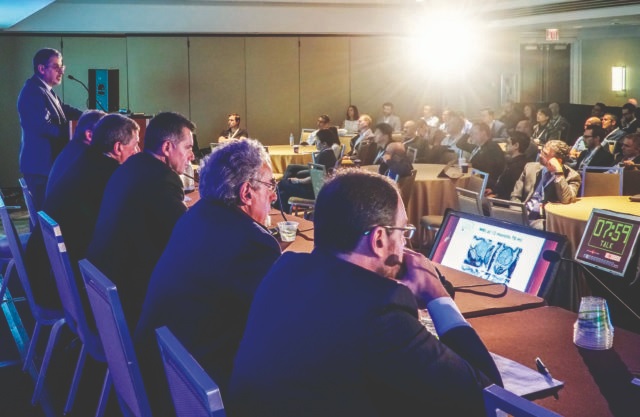 Marc Sapoval 出席GEST2019 关于前列腺栓塞的小组辩论会 2019年的 IR community backs PAE and calls for close collaboration with urologists 2019年当时的国际介入界支持PAE,并呼吁与泌尿科医生密切合作 前列腺动脉栓塞的证据 Evidence for PAEMark Little Speaking first, Mark Little (Royal Berkshire NHS Foundation Trust, Reading, UK) discussed the most important PAE articles published in the last two years,113 papers on PAE have been published. (在GEST2021关于前列腺动脉栓塞的跨学科讨论会上)Mark Little(皇家伯克郡英国国家医疗服务体系-NHS基金会信托,里丁,英国)首先发言讨论了过去两年中发表的113篇论文最重要的PAE文章。
Of these, five were randomised controlled trials (RCTs), and eight were meta-analyses of systematic reviews.
其中,5项是随机对照试验(RCT),8项是系统综述的荟萃分析。
Regarding the clinical effectiveness of PAE, Little said: “We cannot go beyond the superb sham RCT study that came out of Lisbon.
关于PAE的临床疗效,Little说:“我们不能超越来自里斯本的极好的假随机对照试验研究。
Professor João Pisco was a renowned physician, especially within radiology and interventional radiology, both in Portugal and worldwide
” This was a 2019 study published in European Urology, the official journal of the European Association of Urology (EAU), from João Pisco, Tiago Bilhim (Hôpital Saint-Louis, Lisbon, Portugal) et al that found that the improvements in quality of life measurements and International Prostate Symptom Score (IPSS) in patients following PAE are “far superior” to those due to the placebo effect.
“这(假随机对照实验)是由João Pisco, Tiago Bilhim (Hôpital Saint-Louis, Lisbon, Portugal) 等在2019 研究发表在《欧洲泌尿学》,欧洲泌尿学协会(EAU)的官方杂志,(他们)发现PAE后患者生活质量改善测量和国际前列腺症状评分(IPSS)患者远远优于那些由于安慰剂的效果。
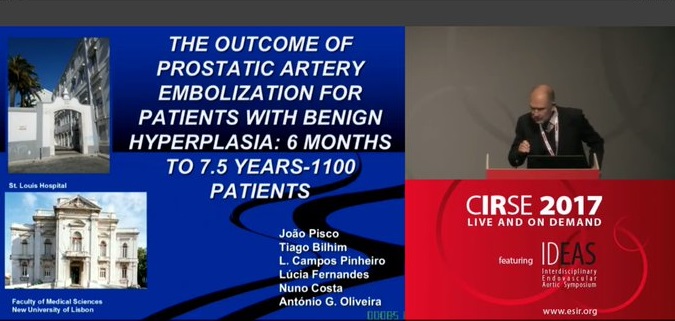
Speaking to Interventional News at the time, Bilhim noted that publishing a paper positively describing PAE in a urology journal has historically been difficult for interventional radiologists.
Bilhim在接受干预新闻采访时指出,在泌尿科杂志上发表一篇积极描述PAE的论文对介入放射科医生来说一直是困难的。
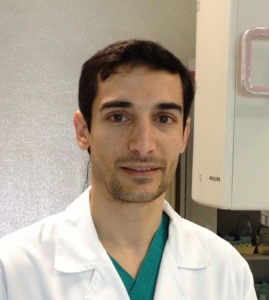 Tiago Bilhim, MD, PhD, EBIR, FCIRSE, FSIR
He hoped that this publication “might help our way into the urology guidelines with PAE”.
他希望这份出版物“可以帮助我们通过PAE进入泌尿外科指南”。
“Anyone who has tried to design a sham trial—which I am trying to do now for genicular artery embolization [GAE]—knows that it is hard work,” Little commented, in praise of the Lisbon group.
LittlePAE假试验时评论说:“任何试图进行膝动脉栓塞的人都知道这是一件艰苦的工作,他赞扬了里斯本组织。”
“On the one hand it is the gold standard study design to refute[ rɪˈfjuːt] 否认真实性 the placebo effect, but there are a number of ethical dilemmas.
“一方面,驳斥安慰剂效应是黄金标准的研究设计,但也存在一些伦理困境。
So it is an ambitious study design, and one that the Lisbon group did extremely well to set up and running and recruit to.
所以这是一个雄心勃勃的研究设计,里斯本小组在建立、运行和招募方面做得非常好。
”In the sham study in question, 80 patients were enrolled, randomised 1:1 to PAE versus a sham procedure with a cross-over design at six months.
在相关的假研究中,80名患者被纳入,随机1:1到PAE,与6个月时进行交叉设计的假手术。
Summarising their findings, Little relayed: “They found a statistically significant refutation of the placebo effect—PAE does better than sham”.
总结他们的发现后,Little 接着说:“他们发现了对安慰剂效应有统计学意义的反驳——PAE比假效应做得更好。”
Asking the question, “Is PAE clinically effective”, Little argued that the answer was a definitive “Yes”, based off this Level 1 evidence.
在问到“PAE临床有效吗”这个问题时,Little 认为,基于这一一级证据,答案是明确的“是”。
Giving a more practical perspective, Little then turned to covering[ˈkʌvərɪŋ] the evidence for altering clinical practice, focusing on papers dedicated to patients with median lobes and to the question of repeat PAE.
给出一个更实用的角度,Mark Little 随后转向覆盖改变临床实践的证据,专注于专门针对中叶患者和重复PAE问题的论文。
“I remember having conversations at CIRSE [the annual scientific meeting of the Cardiovascular and Interventional Radiological Society of Europe] five or so years ago saying ‘Well, perhaps we should exclude patients with a median lobe, they seem to be difficult to treat’,” he said.
他说:“我记得五年前在欧洲心血管和介入放射学会年度科学会议上说过 ‘好吧,也许我们应该排除中叶的患者,他们似乎很难治疗。”
Presenting a 2019 publication from Riad Salem (Northwestern University, Chicago, USA) and colleagues in Abdominal Radiology, looking predominately at imaging correlates: “A simple study,” Little opined, “but nevertheless [it] gives the idea and the introduction of where we sit with regard to the technique of embolizing the median lobe.
展示《腹部放射学》2019 发表文献,他们来自 Riad Salem (西北大学,芝加哥,美国)和的同事,主要关注成像问题:“一个简单的研究,“Little认为,”但它给出了我们关于栓塞中叶的技术的想法和介绍。
” This cohort study showed that 37% of patients had a median lobe—intravesical prostatic protrusion (IPP)—and that 100% of those IPP-positive patients treated with PAE had a decrease in median lobe size following the procedure.
“该队列研究显示,37%的患者有中叶-膀胱内前列腺突出(IPP),100%的IPP阳性患者接受PPE治疗后中叶减小。
While this demonstrated that it was feasible to embolize the median lobe, Little asked “What does that mean clinically, do these patients get better?” He turned to a 2021 study from GEST co-founder Marc Sapoval, first author Tom Boeken (both Hôpital Européen Georges-Pompidou, Paris, France) et al that concluded that IPP is “not a prognostic marker of ineffective PAE in men with benign prostatic hyperplasia (BPH)”. Sapoval, Boeken and colleagues also wrote that severe protrusion could lead to a better response to PAE, “though expected prostate height reductions are mild”. They found that the degree of IPP did not limit the efficacy of PAE in patients with lower urinary tract symptoms (LUTS) due to BPH. 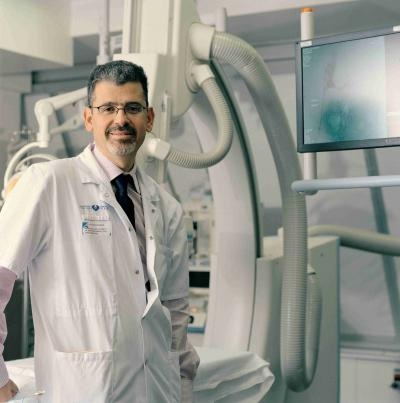 Marc R. Sapoval, M.D., Ph.D., is a professor of clinical radiology and chair of the cardiovascular radiology department at Hôpital Européen Georges-Pompidou in Paris, France. Furthermore, a 2020 paper in the Journal of Vascular and Interventional Radiology (JVIR) from Aaron Fischman (Mount Sinai, New York, USA) and colleagues answered the direct question “Should we be treating median lobes?”, Little reported. Stratifying the median lobes by size (patients were categorised as having non-severe IPP if their median lobe was <10mm, as was the case in 17 patients enrolled in the study, and as having severe IPP if their median lobe was >10mm, as was the case in 37 patients), Fischman et al found that both groups had a statistically significant improvement in IPSS and quality of life scores. “So we should not be scared of median lobes in terms of PAE,” Little concluded. 此外,2020年的一篇发表在《血管与介入放射学杂志》(JVIR)上的论文回答了一个直接的问题:“我们应该治疗中叶吗?”,Little提到。中叶按大小分层,如果患者(17例)中叶为<10mm,患者没有严重的前列腺膀胱内突触,如果患者(37例)中叶为>10mm,则为严重IPP,Fischman等发现两组患者IPSS和生活质量评分均有统计学意义的改善。Little 总结道:“所以我们不应该害怕中叶,”他总结道。 Concentrating on repeat PAE, Little relayed how approximately 20% of PAE patients could be deemed “clinical failures”, in need of further intervention. “Does that mean one in five need surgery?” he asked. Again turning to work from the Lisbon group, which focused on how these patients failed, Little recounted how patients in the study were categorised into two groups: group A (n=39), those who never showed a response to PAE; and group B (n=69), those who had clinical improvement in the first six months following PAE, but then relapsed. The investigators found that in 75% of patients, the blood flow was coming from the previously embolized prostate artery, perhaps indicating under-treatment, while in the remaining 25% of patients, the blood supply was from collateral vessels. At 24–26 months follow-up, 17% of group A had a clinical benefit from repeat PAE. This led Little to comment: “Effectively, if you have got a patient that does not respond initially, they are unlikely to respond. They [those in group A] probably need to be treated with surgery.” In group B, meanwhile, 52% had a significant clinical benefit from repeat PAE. 专注于重复的PAE,很少讲述了大约20%的PAE患者如何被视为“临床失败”,需要进一步的干预。“这是否意味着五分之一的人需要做手术?”他问。再次转向里斯本小组的工作,重点关注这些患者是如何失败的,Little 叙述了研究中的患者如何被分为两组:A组(=39),那些从未对PAE有反应;和B组(=69),那些在PAE后的前6个月有临床改善,但随后复发。研究人员发现,在75%的患者中,血液流量来自以前栓塞的前列腺动脉,这可能表明治疗不足,而在其余25%的患者中,血液供应来自侧支血管。在24-26个月的随访中,17%的A组从重复PAE中获得了临床获益。这让Little发表评论:“实际上,如果你的病人最初没有反应,他们不太可能有反应。A组的患者可能需要接受手术治疗。”同时,在B组中,52%从重复PAE中有显著的临床获益。 AUA guidelines
Little also considered the Society of Interventional Radiology (SIR) consensus panel conclusions, which were the focus of much of the day’s discussion.
几乎没有人考虑到介入放射学学会(SIR)共识小组的结论,这是当天大部分讨论的焦点。
Published in JVIR and authored by Clifford Davis (College of Medicine and Radiology, University of South Florida, Tampa, Florida) et al, the summary of the SIR consensus panel on PAE regarding the development of a research agenda for the procedure concluded without direction: “Level 1 data are required to be included in the AUA guidelines for treatment of BPH.
由官方授权Clifford Davis (College of Medicine and Radiology, University of South Florida, Tampa, Florida) 等发表在JVIR,总结了美国介入放射协会(SIR)前列腺动脉栓塞(PAE)共识小组,关于前列腺动脉栓塞研究议程的发展过程得出结论并没有方向性:“一级数据需要包括在美国泌尿协会(AUA)BPH治疗的指南中。
Because of concerns with all three study designs, the panel did not reach a consensus.
由于对所有三种研究设计的担忧,该小组并没有达成共识。
Further meetings are planned with the panel to select among these research designs.
计划与该小组举行进一步的会议,在这些研究设计中进行选择。
”The three research designs mentioned were:
上述三种研究设计分别为:
i) RCT of PAE versus sham with crossover of the sham group. i) PAE与假手术组交叉的随机对照试验。
(ii) RCT of PAE versus simple prostatectomy.
(ii) PAE与单纯前列腺切除术的RCT。
(iii) RCT of PAE versus holmium laser enucleation of the prostate/thulium laser enucleation of the prostate.
(iii) PAE与钬激光摘除前列腺/铥激光摘除前列腺的RCT试验。
The SIR consensus panel ultimately recommended a non-industry-funded registry to obtain real-world data.
SIR共识小组最终建议一个非产业资助的注册,以获取真实世界的数据。
Currently, the AUA guidelines state that “PAE for the treatment of LUTS secondary to BPH is not supported by current data and trial designs, and benefit over risk remains unclear; therefore, PAE is not recommended outside the context of clinical trials.
目前,AUA指南指出,“BPH继发于LUTS的PAE不得到目前的数据和试验设计的支持,益处大于风险仍不清楚;因此,在临床试验之外不推荐PAE。
” The guidelines claim this advice is based on expert opinion.
该指导方针称,这一建议是基于专家的意见。
“I am a UK interventional radiologist,” Little acknowledged, “so I will be as objective as I can be in this argument.
“我是一名英国介入放射科医生,”很少承认,“所以我将在这个论点中尽可能客观。”
” He talked the GEST audience through the guidelines from the perspective of the SIR consensus paper.
他从SIR的共识文件的角度,通过指南说服了最好的听众。
He noted that the AUA guidelines included RCTs with more than 12 months of outcome data, but that the AUA wanted PAE studies to include a 24-month follow-up “to be equivalent to current data on other surgical therapies for LUTS resulting from BPH”.
他指出,AUA指南包括了超过12个月结果数据的随机对照试验,但AUA希望PAE研究包括24个月的随访,“与BPH导致的其他LUTS手术治疗的当前数据相当”。
Citing a 2020 JVIR study from Iñigo Isausti (Complejo Hospitalario de Navarra, Pamplona, Spain) et al, Little related how the group set out to compare clinical and functional outcomes of PAE with those of transurethral resection of the prostate (TURP) for the treatment of LUTS secondary to BPH.
引用 Iñigo Isausti (西班牙Navarra 医院)等人2020年的一项发表在JVIR研究,该小组如何比较PAE与经尿道前列腺切除术(TURP)治疗BPH继发于LUTS的临床和功能结果。
Isausti and colleagues reported: “Reduction of LUTS in the PAE group was similar to that in the TURP group at 12 months, with fewer complications secondary to PAE.
Isausti及其同事写道:“在12个月时,PAE组中LUTS的降低与TURP组相似,PAE继发的并发症较少。
”However, AUA require two-year data.
“然而,AUA需要两年的数据。
“We are very fortunate to have Dominik Abt here,” Little said, “as the lead author of this paper”.
“我们很幸运,Dominik在这里,”这是本文的主要作者。”
Abt (Klinik für Urologie, Institut für Medizin, Universität St Gallen, St Gallen, Switzerland) et al conducted a study comparing the efficacy and safety of PAE and TURP in the treatment of LUTS at two-year follow-up.
Abt(瑞士圣加伦大学圣加伦医学研究所克里尼克大学)等人进行了一项研究,比较了PAE和TURP治疗LUTS的有效性和安全性。
They concluded in February 2021: “Inferior improvements in LUTS/BPO [benign prostatic obstruction] and a relevant re-treatment rate are found 2 years after PAE compared with TURP.
他们在2021年2月得出结论:“与TURP相比,PAE后2年发现LUTS/BPO[良性前列腺梗阻]的改善不良和相关的再治疗率。
PAE is associated with fewer complications than TURP.
PAE比TURP相关的并发症更少。
The disadvantages of PAE regarding functional outcomes should be considered for patient selection and counselling.
在患者的选择和咨询方面,应考虑PAE在功能结果方面的缺点。
” Their patient summary was: “PAE is safe and effective.
他们的病人总结是:“PAE是安全有效的。”
However, compared with TURP, its disadvantages regarding subjective and objective outcomes should be considered for individual treatment choices.
然而,与TURP相比,其在主观和客观结果方面的缺点应考虑到个别治疗的选择。
”As the reintervention rate was 20% in the PAE group, Little said what treatment these patients should get next is “where the debate now lies”.
由于PAE组的再干预率为20%,Little 说这些患者下一步应该得到什么治疗是“现在争论的所在”。
“I do not think this paper is a death knell for PAE at all,” he opined.
“我认为这篇论文根本不是PAE丧钟,”他说。
“Actually, I think it shows that it is safe and effective, but, we need a reasonable discussion with our patients about what we can achieve with the technology based on patient selection, anatomy selection, pre-procedural imaging and planning.
“实际上,我认为这表明它是安全有效的,但是,我们需要与患者合理地讨论,我们通过基于患者选择、解剖选择、术前成像和计划的技术可以实现什么。”
”He concluded that PAE is safe and effective, and, in his eyes, gives patient’s a choice, which he believes is “really important”.
他的结论是,PAE是安全有效的,在他看来,它给了病人一个选择,他认为这“真的非常重要”。
Citing the sham trial and RCT data to two-years follow-up, Little summarised that there is “lots of level 1 and 2 evidence on PAE, which cannot be argued against in terms of the position statement of ‘Benefit over risk remains unclear’ [from the AUA guidelines].
引用两年的虚假试验和随访的随机对照试验数据,Little 总结说“有许多关于PAE的1级和2级证据,关于‘优于风险的立场陈述仍不清楚’[来自AUA指南]。
”He continued: “I am not sure that we can say that with the current evidence case we have,” something fellow panellist and interventional radiologist Riad Salem (Northwestern Memorial Hospital, Chicago, USA) said he agreed with.
他继续说:“我不确定我们是否能说,根据我们目前的证据,”小组成员和介入放射科医生Riad Salem(美国芝加哥西北纪念医院)同意他的观点。

Going through the AUA guidelines comparing how PAE was assessed compared to alternative therapies, James Spies (MedStar Georgetown University Hospital, Washington, DC, USA) said he thought the recommendation not to perform the procedure outside of clinical trials was “actually a value judgement of one specialty of another” that “seems a little unusual”.
通过AUA指南比较费用评估与替代疗法相比,James Spies (MedStar 乔治敦大学医院,美国华盛顿特区) 说,他认为不在临床试验之外进行该程序的建议“实际上是另一个专业的一个价值判断”,“似乎有点不寻常”。
“This is not pointing fingers at the AUA,” he added.
“这并不是把矛头指向AUA,”他补充道。
“I was former chair of the standards committee of the SIR, and I am a former [SIR] president—clinical practice guidelines really are intended to be evidence-based, and by-and-large they are.
“我是SIR标准委员会的前主席,我也是SIR前主席——临床实践指南确实是循证的,总的来说,它们是循证的。
The process the AUA use is actually very good.
AUA使用的过程实际上非常好。
But when it gets down to it, it is difficult to separate our preconceived notions from our review of evidence.
但说到底,很难将我们的先入之见与我们对证据的审查区分开来。
“Again, this is not a knock on the AUA, but my opinion is that guidelines reflect the opinions of the organisations that create them.
“同样,这并不是对AUA的打击,但我的观点是,指南反映了创建它们的组织的意见。
That is because it is almost impossible for a group in a room to go beyond what is not comfortable for them.
这是因为一个房间里的一群人几乎不可能超越他们不舒服的地方。
In some ways, the SIR is never going to write a guideline that says PAE is bad, probably, unless we have some definitive data, and the AUA may never write one that says it is good or at least should be on the list.
在某些方面,SIR永远不会写一个说PAE是坏的指南,除非我们有一些明确的数据,而AUA可能永远不会写一个说它是好的,或者至少应该在名单上。
So I would agree we need to increase our data, but I am just not sure we are ever going to be able to get there.
所以我同意我们需要增加我们的数据,但我只是不确定我们是否是否能够做到这一点。
This is a benchmark procedure for urologists, and, just like some other specialties that we work with, it can be difficult to get adoption.
这是泌尿科医生的一个标准操作,就像我们合作的其他一些专业一样,它可能很难被采用。
”When thanking Spies for his talk, Golzarian noted that Spies is a “pioneer” for uterine fibroid embolization (UFE), a procedure now widely recognised and performed by interventional radiologists: “It is like revisiting history; we are 15 years behind with PAE [compared to UFE], but hopefully we will see the same acceptance,” he commented.
当感谢James Spies的演讲时,Golzarian指出,James Spies 是子宫肌瘤栓塞(UFE)的“先驱”,这种手术现在被介入放射科医生广泛认可和执行:“这就像回顾历史;与UFE相比,我们比PAE落后了15年,但希望我们能看到同样的接受。”
Quality of evidence for PAE: The urologist perspective
| ||||||||||||



